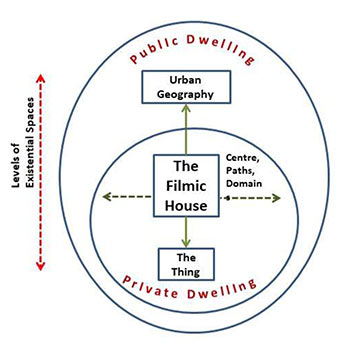This dissertation aims to study the ‘Filmic House’ in Hindi cinema, a popular cultural medium, from an architectural standpoint by a systematic exploration of its architectural space. The domestic space is a most common cinematic image in cinema. In many cases, it forms the principal setting and displays distinctive characteristics. ‘Filmic House’ is defined as domestic space rendered in a film. The first chapter of Introduction explains some of the basic premises of the thesis, defines and creates a background for the subject of ‘filmic house’ from various perspectives, presents a review of literature and sets out the objectives and research questions. The second chapter on research design lays out the manner in which this dissertation deals with the subject area. The research design includes – devising a model for analysing the filmic house, setting out a typological approach for the study, explaining the criteria of selecting films for discussion, and making a filmography for each of the three typologies under consideration. Towards the end of this chapter is described the common methodology adopted for each of the three typology chapters. The thesis has discussed three dominant urban architectural typologies – the bungalow, the chawl and the apartment block – by way of their filmic representations. A chapter each is dedicated to each typology where they become individual essays, generating a set of readings. Finally, this research has produced a comprehensive appreciation of representation of domestic space in Hindi cinema and it furthers the understanding of architecture of home as a narrative and social space. This would be of interest to both film and architecture students and practitioners.
